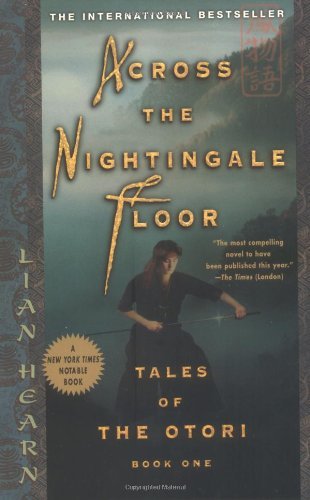
‘Across the Nightingale Floor’ is a young adult fantasy loosely inspired by Japanese history and culture, with elements of political scheming, romance, and a hint of magic. Its an easy read with plenty to enjoy, and whilst it perhaps lacks the depth of some more modern YA, it retains a page-turning quality.
Takeo has been brought up amongst the Hidden – a reclusive and spiritual tribe who seek peace and religious devotion. However, the Hidden are persecuted, and when Takeo’s village is burnt to the ground, he finds himself rescued by the mysterious Lord Otori Shigeru. Lord Otori has big plans for Takeo – for it turns out Takeo’s father was a famed assassin of the Tribe, an ancient network of families with preternaturally enhanced skills. Takeo must reconcile his peaceful upbringing with this bloodthirsty legacy – and navigate the multi-dimensional chessboard of the wars between the clans, a board on which he never expected to become a player.
‘Across the Nightingale Floor’ utlilises dual perspectives – Takeo’s, as he takes on his new role as Lord Otori’s protege and learns his Tribe-inherited abilities, and Kaede’s, a young woman who has lived her life as a hostage, who suddenly finds herself of marriageable age and used as a bargaining chip in the wars between the clans. Each perspective offers something unique. Both have lived very sheltered lives, in different ways, with minimal exposure to the politics and complexity of the clans – thus, as they are thrust into the world, the reader learns with them. Where Takeo is naturally reserved and quiet, preferring to stick to the shadows, Kaede is more outgoing, an urge she must often suppress in a world where women rarely have the power.
The worldbuilding is intriguing. I believe it only loosely resembles true Japanese history, but taken on its own, the system of the clans and the Tribe paints an intriguing backdrop for the story to progress. The magic of the Tribe is clever, as is the way it has shaped the political sphere. Society is one that stands firmly on honour and ceremony, with pretty words and gifts hiding a backdrop of lies, backstabbing, and quiet assassination attempts to manouevre things in a chosen direction. Its an easy world to get sucked into and believe.
There is, of course, a central romance, and one that will be a point of contention for some. This is very much a young adult novel – the protagonists are in their early to mid teens, and both previously very sheltered, so read young, despite the responsibilities placed on their shoulders. On that vein, the romance is an immature first love, filled with instant attraction and overly dramatic feelings. It fits both protagonists and where they are in their personal journeys, but can feel frustrating compared to the more nuanced way much modern YA explores romance.
I first read ‘Across the Nightingale Floor’ in my early teens, and loved it. Having read very little fiction inspired by non-Western cultures, I loved the worldbuilding, the magic system, and the forbidden love affair between Takeo and Kaede. Rereading childhood favourites as an adult is always an interesting experience – many aspects don’t stand up in the same way, but many remain beautifully coloured by nostaglic fondness. This is a book that will appeal more to the teenage audience it is designed for than adults, and that is the way it should be.
Overall, ‘Across the Nightingale Floor’ may not be the strongest or most well written book in the world, but its an enjoyable read for its intended teenage audience with many individual highlights. Recommended for fans of political scheming, YA that actually feels like its about and for teenagers, and soft magic systems.
Published by Picador (Pan Macmillan)
Paperback: 26th August 2002








